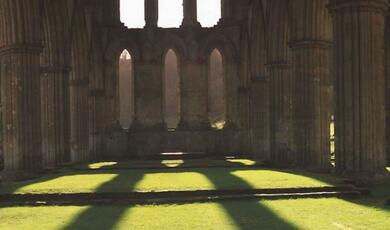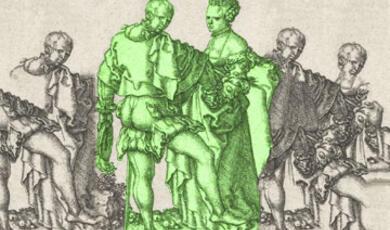Medieval Music: The Lands of the Bell Tower
Share
- Details
- Transcript
- Audio
- Downloads
- Extra Reading
Many thousands of visitors to London each year return home thinking that Big Ben is the name of the great clock tower at Westminster. Londoners know that this is the name of the bell. This is a legacy from the Middle Ages when bells had names, ‘tongues’ and ‘mouths’. They could be baptized and might even be taken down, and filled with thorns, as a punishment if they did not ring of their own accord in a time of crisis. Where the bell-towers on the skyline ended, there Christian Europe had its frontiers.
This final lecture of the series, given in the church whose bells are commemorated in nursery rhyme as the ‘bells of the Old Bailey’, will explore the place of the bell tower and its inhabitants in the medieval imagination.
Download Transcript
5 May 2016
The Lands of the Bell Tower
Professor Christopher Page
Imagine a road, stretching out of a town some time in the fourteenth century. People on foot or on horseback, together with wheeled cart traffic, come and go. One either side, there are mostly open fields, save for a leper hospital. With a community of perhaps ten or fifteen lepers, the hospital has a chapel where the only kind of therapy deemed really effective is on offer: daily prayer and worship. The house is funded from the revenues of a nearby fair, but that does not absolve the inmates from the need to beg for alms as people pass by on that road. One of them is a woman seated by the gate of the leper house. You see her on the first page of your handout, and she is speaking: ‘some good, my gentle master, for god’s sake’. She is also ringing a bell to warn people of her presence but also to attract the attention of the charitable.
Forlorn and distressing though that image may be, it offers a fitting introduction to the subject with which I close my series of lectures for my second year. Bells, some small enough to hold in the hand, others so massive it took days to hoist them into position, accompanied medieval experience from the depths of misery to the heights of religious exaltation and joy. Men and women were summoned by bells throughout their lives, especially the many thousands who committed themselves to some form of the religious life. Here is the historian Philippe of Harvengt, near Mons, who died in 1182:
The famous task that bells perform is so widely cultivated, that there is scarcely any church or monastery in which the congregation is summoned without the aid of bells, or that the liturgy is celebrated without them heralding the service. When they sound, the weary silence of the night is dispelled, sleepers are roused to an alert wakefulness, clergy approach the church for the liturgy, or for the dawn service, and workers keep watch in various places in order to do their handiwork. The bells sound, and speak first with a kind of indispensable joy, then the clergy follow with chant or with whatever it is they have been charged to do….
Is there any better place to ponder the ‘the famous task that bells performed’ in the Middle Ages than London? You will have seen those early engravings of Shakespeare’s city, showing what is still essentially the London known to Geoffrey Chaucer in the Middle Ages. The spires of ancient churches crowd together: St. Mary le Bow, St. Bride’s Fleet Street, All Hallows by the Wall, St. Mildred’ Bread Street. What a wonderfully expressive litany of names that is, deeply evocative of London’s history; one of them inspired John Betjeman to capture the mystique of bells on a London Sunday, when all at first is quiet:
Sunday Silence! with every street a dead street,
Alley and courtyard empty and cobbled mews,
Till “tingle tang” the bell St. Mildred’ Bread Street
Summoned the sermon taster to high box pews,
And neighbouring towers and spirelets joined the ringing
With answering echoes from heavy commercial walls
Till all were drowned as the sailing clouds went singing
On the roaring flood of a twelve-voiced peal from Paul’s.
As a great haunter of churches, Betjeman knew how that chorus of bells is achieved. You will know it yourself if you have ever climbed the narrow wooden stairs to share the cramped space of a bell-chamber with dust and pigeons. It is done with thick planks, wooden wheels that evoke the lost art of the country wheelwright and heavy ropes: all powered by human muscle. It is a moving example, or so I find it, of pre-modern technology once shared by the great sailing ships, or the cathedral architects with their wooden scaffolding, ropes and pulleys, and yet here it still is in use, serving its original purpose. What is more, many of the bells in these chambers are as ancient as the technology used to sound them. Some contain sixteenth century musical instruments, in effect, that still sound every Sunday. Here, for example, is the peal of bells in the church of St. Bartholomew the Great at Smithfield, which stands not far from here. The bells in this peal are all pre-Reformation: they sing now as they did in the time of Shakespeare:
St. Bartholomew the Great; the peal
The survival of the bells at St. Bartholomew provides a reminder that London has many ancient peals, despite the ravages of fire and war. And if this city is the best place to ponder them, this church of St. Sepulchre without Newgate is one of the best places within London. The great bell of this church was the one that tolled when the condemned were led out of Newgate prison towards Tyburn, and anyone who has looked around it knows that St. Sepulchre houses the small hand-bell that was rung outside the condemned cell at midnight in the prison, before the morning of an execution. This is also a very important church for the art of change-ringing; the first ever peal of 5,040 changes may have been rung here in 1690, by the Ancient Society of College Youths, who still ring here today. Some off them are present. And it is probably the bells of this church that figure in the rhyme ‘Oranges and lemons’, as ‘the bells of Old Bailey’, just across the road. Who knows how old this song is? We do know that it first appears in Tommy Thumb’s Pretty Song Book of 1744, but the verse memorialize the bells of some great city churches, almost all of them medieval in origin. I cannot resist offering you a performance of the earliest known version, which actually begins ‘Two Sticks and an Apple,/ Ring ye Bells at Whitechapple’. You have the text on the second page of your handout, together with a page from Tommy Thumb’s Pretty Song Book which gives another well-known rhyme headed by a woodcut showing the clustered spires of the London churches:
Two Sticks and an Apple,
Ring ye Bells at Whitechapple,
Old Father Bald Pate,
Ring ye Bells [of] Aldgate,
Maids in White Aprons,
Ring ye Bells a[t] St. Catherins,
Oranges and Lemmons,
Ring ye Bells at St. Clemens,
When will you pay me,
Ring ye Bells at ye Old Bailey,
When I am Rich,
Ring ye Bells at Fleet ditch,
When will that be,
Ring ye Bells at Stepney,
When I am Old,
Ring ye Bells at Pauls.
Viewed as musical instruments, bells behave in a complex way. Let us imagine one being struck. After the initial clash of metal on metal we perceive a note, called the prime, though it is not always identified by listeners in the same way. Stacked immediately above the prime we hear a minor third; and much else, growing fainter, above that. Given the way the harmonic language of western music has developed, we now hear large bells as essentially grave and somber, even threatening at times, depending on how they are rung, but it seems that they have long been heard that way. The prime then dies away leaving what is called the hum, which is an octave lower. This hum, especially in a great bell, emanates from the body of the bell and yet it seems to come from nowhere since there was no impact to create it and the note has no front, so-to-speak. Taken altogether, these effects are festive and yet somehow inherently grave; thoroughly material, like the bell itself, and yet somehow unearthly.
The practice of sounding what Shakespeare calls the ‘sullen bell… tolling a departing friend’ reaches back a very long way. Already in the Bayeux tapestry you can see two men with handbells following the corpse of Edward the Confessor as it is carried towards Westminster Abbey. They appear on the third page of your handout. A particularly sharp association between bells and death is offered by the jailer’s bell I mentioned earlier, which was rung outside the condemned cell at midnight with an accompanying rhyme:
All you that in the condemned hole do lie,
Prepare you for tomorrow you shall die;
Watch all and pray: the hour is drawing near
That you before the Almighty must appear;
Examine well yourselves in time repent,
That you may not to eternal flames be sent.
And when St. Sepulchre’s Bell in the morning tolls
The Lord above have mercy on your soul.
The composer Handel described England as ‘the ringing isle’, so many bells did he hear when he first settled in London. We still hear them, and it is a medieval legacy to us that the complex sound of bells still has a place in our soundscape despite the clamour of noise generated by traffic and machinery. Few things are more evocative of a great city with a medieval core than public bells, chiming the hours at slightly different times; as Philip Larkin says, bells in clocks do not so much proclaim the time as discuss it, each one intervening when it thinks fit because the clocks and their bells do not quite agree what time it is. In London you can still hear that, or just about; in cathedral cities, and in Oxford and Cambridge, you certainly can. It was in the fourteenth century, for the most part, that such clocks began to mark the passing of the hours in great municipal or cathedral time pieces; these remarkable pieces of ironmongery with their gears, springs and weights, some of them still in working order, marked the beginning of what has been called merchant’s time: the time of those who reckoned the hours, minutes and seconds with care because they translated into pounds shillings and pence. However evocative and picturesque they may seem, bells had their place in the making of London as a great financial and commercial centre.
In England, bells in great towers were so common, in country places as well as in the cities, that they found their way into the irrepressible grotesqueries of medieval art, notably the borders of books of hours and psalters. You have an example on your handout: a rabbit pulling the ropes of two bells in the bell tower of a church. As this parody suggests, to approach a medieval settlement at certain times of the day, notably towards dawn, was to hear bells sooner or later. It was when you heard a bell, not when you saw a light or the smoke of a fire, you knew that you had found civilization, or something like it. Here, for example, is a description a woman and her child making their way through the medieval English countryside during the night and into the dawn. I take it from a fourteenth-century English romance:
The maiden took the baby with her and stole away in the evening. She passed over a wild heath through field and wood all the long winter night. The weather was clear and the moon bright, and she came to the edge of a forest…She arose and continued on, passing many walls and houses until she saw a church with a fair, high steeple. There were no streets or town, only a convent of nuns well prepared to serve God day and night …Then dawn arrived…The porter arose, said his prayers, rang the bells, lighted the candles, laid out the books, and prepared for the day.
That picture could be broadened, indeed extended to the whole of Western Europe. In the Middle Ages, travellers knew they were leaving what they called Latinitas, the place where worship was conducted in Latin – broadly speaking Western Europe – when they ceased to hear bells and see bell towers. Metal bells were not widely used in the eastern churches of Byzantium until the twelfth and thirteenth centuries when they were adopted, or so it seems, under the influence of crusader churches. That is a sweeping claim, and one that has often been made, but the crusaders did set about the work of founding bells as soon as they began to carve out the Latin kingdom of Jerusalem at the beginning of the twelfth century. Here, for example, is the chronicler Albert of Aachen, writing around the year 1100:
It pleased the highest prince in Jerusalem, duke Godfrey [of Bouillon], and all others, that twenty brothers in Christ should be installed in the Church of the Sepulchre of the Lord for the celebration of the liturgy…thus fittingly restored for divine service by the catholic duke and the Christian princes, they commanded bells of brass and other metals to be cast, at whose signal the brothers would hurry to the church to sing praise in psalms and to celebrate Masses, and the people hearing this would hasten together.
Bells were so strongly associated with the Christian civilization of the Latin west, and with its contested frontiers, that Islamic armies are reported to have removed them in the Arab conquest of Spain. In the year 977 the de facto ruler of Al-Andalus, Almançor, took the bells from the Church of Santiago in Compostela to the Great Mosque of Córdoba; but with the reconquest of that city by King Ferdinand III in 1236 they were taken back. Here is the chronicler Rodrigo Jiménez de Rada (d. 1247), archbishop of Toledo, who tells the story as succinctly, and as plainly, as one could wish:
Almançor….took the bells of Santiago to the Mezquita in Córdoba, to the shame of Christian people, where they were hung to perform the office of lamps, but King Ferdinand had those same bells taken to St. James, and they were restored to the church of Santiago.
Taken down from its tower and laid on the ground, the bell of a great church like Santiago de Compostela would seem an inhuman thing: massive, cold and thoroughly dead. But that is not how people in the Middle Ages spoke of bells, and (under their influence) it is not how we speak of them now. We still say that bells have a lip or a mouth, and the clapper is sometimes called the tongue; specialists in these things also speak of the waist of a bell and its shoulder. And there was another respect in which a bell might be humanized. The clue lies hidden in the antiphon that I would now like you to hear: Asperges me domine: ‘Thou wilt sprinkle me, O Lord, with hyssop and I shall be cleansed. Thou wilt wash me, and I shall be washed whiter than snow. Pity me, O God, according to Thy great mercy’:
Antiphon: Asperges me
That antiphon was often appointed to be sung while a bell was being blessed by a priest or bishop, for a bell was not a mere piece of ecclesiastical furniture like a lock or a bolt on a door. It was a participant in the rites made sacred by holy water. A bell, in effect, was ordained to be a bell in a ceremony, somewhat as a priest was ordained to be a priest. The Roman church of the Middle Ages had a rite for the blessing and anointing of an ecclesiastical bell, which included these momentous lines:
Bless, O Lord, this water with heavenly benediction, and let the power of the Holy Spirit come upon it, so that when this vessel…is moistened with it, the power of enemies, the shadow of phantoms, the onrush of storms, the beating current of rivers, the harm of thunders, the disaster of tempests and all stormy winds may recede far away wherever its ring will sound. When Christians hear its clamour, let the devotion mounting within them increase, so that, hastening to the lap of their merciful mother, they may sing a New Song to you…
You will have spotted the close association there between the ringing of bells and storms. The process whereby humankind gradually learned that storms are not caused by the demons of the air (which bells, high in their towers, were in a good position to attack) but rather by particular meteorological conditions, forms an intriguing chapter in the history of scientific thought. Indeed it is also part of the history of religion since the great reformers of the sixteenth century included some who were opposed the diabolical interpretation of storms and the associated ringing of bells.
If you think that the ceremonial moistening of a bell sounds like a baptism, I have to agree, and so did those reformers, who opposed the practice. Some medieval writers are quite explicit about what they call a baptismus campanarum, ‘a baptism of bells’. But perhaps the most extraordinary chapter in the humanization of bells concerns their need, in certain circumstances, to atone for their misdeeds, indeed to do penance.
Listen to that antiphon again:
Asperges me
‘I shall be washed whiter than snow’, runs the text. Bells could be in a state of grace, sinless like Adam until he ate the fruit of the tree; but again like Adam, a bell could fall in more senses than one. Let me introduce you to the English scholar Alexander Neckham who died in 1217, and his treatise De Naturis Rerum, ‘On the Natures of Things’. In this book he not only says that bells are, in effect, baptized; he also records the procedure for punishing a bell when it commits a grave sin:
A bell represents the office of a preacher, whence, in some places bells are baptized to show that nobody is permitted to preach save those that have undergone baptism. If, by some unfortunate chance, a bell falls and kills a man, then it is filled inside with thorns as a mark of penitence. When seven years have passed, the bell is reintroduced to its former function and sounded.
So that is how a bell does penance. The punishment alludes to God’s rebuke to Adam just after the fall: ‘Thorns also and thistles shall [the ground] bring forth to thee’.
Given that bells were capable of being baptized and of committing a crime, it is hardly surprising that they were often given familiar and common names. This is still with us, for most Londoners know that Big Ben is actually the main bell in the clock tower at Westminster, not the tower itself. In the Middle Ages, however, it was very common for bells to have their names inscribed upon them, often with an inscription in the first person as if the bells were speaking. Many of these inscription are prayers as if the bell, when sounded, is to send the words heavenwards, translating human speech into the pure and reverberant language of bells. Some of these inscriptions are quite brief, perhaps just the angelic salutation Ave maria, sometimes extending to part of the Magnificat, Ave maria gratia plena dominus tecum. Others, especially the later examples, go further, quoting pieces of the liturgy and naming the bell founder, as in this Italian example from 1268, which I here translate:
HAIL MARY FULL OF GRACE THE LORD IS WITH THEE BLESSED ART THOU AMONG WOMEN + CHRIST OVERCOMES, CHRIST REIGNS CHRIST RULES + THIS IS THE BELL OF THE FRIARS MINOR OF THE CITY + ANDREOCTUS SON OF BARTHOLOMEW THE PISAN MADE ME + 1268.
Some other inscriptions are curses, the bell issuing a stern warning to anyone who might seek to move it from its rightful home. A bell which hung in the tower of an abbey in France, from 1639 until some time in the later nineteenth century, was inscribed with these words: ‘Dubois the Abbot had me cast, to call the people to holy prayers. I cheerfully obey this command. Let whosoever would remove me from my office and my location perish and be struck by lightening.’ (The threat is not an empty one, for there are many recorded cases of bell ringers being electrocuted by lightning strikes, presumably when they were hard at work trying to exorcise the demons of the air). Most inscriptions were less threatening. One of the earliest English bells to survive simply proclaims RICARD DE WYMBIS ME FIST, ‘Richard from Wimbish made me’. (You will notice, by the way, that the bell speaks in French; bells could do that in the wake of the Norman Conquest). Another medieval bell speaks in verse, calls itself as Catherine, presumably in honour of Saint Catherine, and announces that it will pray to the Virgin Mary. The inscription runs:
IN GOD IS AL
QUOD GABRIEL :
Ι KATERY(N)E GODDES DERLYNG
TO THE MARI SHAL I SY(N)GE.
In some cases the donor of the bell speaks through the sound of his or her gift, as in:
HELP MARI
QUOD ROGER OF KIRKEBY
There is a strong sense here of something magical, or if that seems the wrong word, of conjuration and exorcism. The supernatural power that a saint could work through bells bearing his name was well known to the medieval Pilgrims who visited the shrine of St. Thomas Becket, for they often returned home with little bells marked with the name ‘Thomas’. These Thomas bells were not just a token of that saint; they were his agents in the home, far from the shrine where his body lay. This continuing humanization of the bell could sometimes be carried to the point where bells were expected to ring of their own volition and according to their own good judgment. According to the thirteenth-century Life and Miracles of St. Anthony of Padua, for example, the people of Lisbon, where Anthony was born, realised that their native son had been canonised far off in Rome ‘because of the wondrous fact that the bells of the same city, with nobody touching them, gave sound all by themselves’. Perhaps that is why one of the chants for St. Anthony summons bells, here called by the standard medieval Latin name of cymbala, to join other musical instruments in praising the saint. You have the text on your handout. Since it is very brief, I have asked Catherine to sing it twice.
Sono tubae tympano
cithara psalterio
cymbalisque deum choro
chordis organo
laudet in Antonio
mystice cor meum.
May my heart praise God through Anthony, mystically in the music of trumpet, harp, psaltery, bells, with strings and with the organ
Given the sacred character of a bell, blessed and anointed by the bishop or priest, it was not something that anybody could have. Some had rights to a bell and some did not. Here, for example, is a passage from the foundation charter for the hospital of Kingsthorpe in Northampton, dated 1200:
We grant that the liturgy be celebrated in that place, and that in perpetuity there be only two altars: one in the chapel of the Holy Trinity, and the other in the chapel of St David, And [we grant] only one bell to be rung, and a cemetery for the burial of the poor, of pilgrims, and of any others dwelling there.
Or there is this, where Peter des Roches, bishop of Winchester, legislates for the bells of the hospital in Portsmouth. I quote:
…in the aforesaid Hospital, Divine Service may be celebrated, according to the parochial rite of the Church of Portsmouth…and they may have two bells, not exceeding the weight of the bells of the Mother Church, which shall only ring at Matins, and Masses, and Vespers, and for the Dead…
Or again this, from the year 1293:
In the same year the lepers of Dunstable set up a larger bell beyond the entitlement of their house, upon two wooden supports; but the Prior [of Dunstable priory], learning of this, removed it and brought it into our cloister. He restored it to them afterwards, on the condition that they would by no means use this or any other bell to summon our parishioners or any other congregation.
Although a bell is a decidedly material thing, it was widely believed that God used invisible bells to make his will known or to give a warning. Thus we read in a thirteenth-century life of Otto, Bishop of Bamberg, that his retinue one day passed the night camped in a field on the outskirts of the city, and
…in that place, where two nut trees planted long ago still survive, it is often reported that the noise of bells can be heard, so that the sound is clearly audible to the local people…
There is a similar report in the life of Celestine V, who was pope for just five months in 1294:
Entering the oratory they began to celebrate the divine office. They heard the sound of many great bells. This place was so remote from the habitations of men that it could not be the sound of any bell located nearby. The men were astonished and therefore wondered much upon hearing such things. Two of them left the oratory; raising their eyes and ears to heaven, they burst into tears. When the office was over, the four men were in a frightened and tearful state, saying: ‘Where is the place where these bells are being made to sound?’… At the hour of Vespers, entering for the office, they heard a great sound of bells from the beginning until the end. At all of the hours, day and night, these four men heard that same sound until they left…All four turned to the Lord and assumed the monastic habit, giving all they had to the poor…
Bells in the Middle Ages could change your life.
© Professor Christopher Page, 2016
This event was on Thu, 05 May 2016
Support Gresham
Gresham College has offered an outstanding education to the public free of charge for over 400 years. Today, Gresham plays an important role in fostering a love of learning and a greater understanding of ourselves and the world around us. Your donation will help to widen our reach and to broaden our audience, allowing more people to benefit from a high-quality education from some of the brightest minds.


 Login
Login









